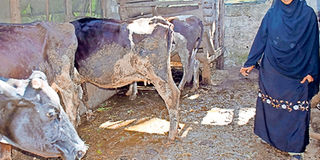Farmers ring their cowsheds with nets to beat tsetse flies

Aloise Maria on her dairy farm in Ukunda. Her cows have remained healthier since they began sleeping under nets. PHOTO | WINNIE ATIENO | NMG
What you need to know:
- The Kenya Tsetse and Trypanosomiasis Eradication Council (KENTTEC) has introduced net technology, which keeps the flies at bay.
- The nets protect animals that are mainly kept under the zero-grazing.
- Farms that have put the net in their cowsheds have reported 100 per cent survival.
- KENTTEC chief executive Pamela Olet said 38 infested counties will not achieve food security and nutrition goals if the tsetse fly problem is not addressed.
On the outskirts of Ukunda Town in Msikitini, Mary Mwasafu is busy milking her dairy cow in one of the sheds on her two-acre homestead.
The shed has a milking section, feeding and sleeping or resting quarters, offering the animals ample space.
“I currently have four dairy cows, two Friesians, one Jersey and one Ayrshire, having started the business in 2009 after investing Sh450,000,” says the 45-year-old.
She milks two of the four animals and getting 17 litres of milk, which she sells at Sh80 each.
However, despite her efforts, her dream of growing her agribusiness had been thwarted by tsetse fly infestation in the county.
“I have been unable to grow my herd because of the flies. So far, I have lost six dairy cows to tsetse fly-related diseases,” she says
But there is hope for Mary and other cattle keepers at the Coast as the government introduces cowshed nets.
The Kenya Tsetse and Trypanosomiasis Eradication Council (KENTTEC) has introduced net technology, which keeps the flies at bay.
KENTTEC regional coordinator Moses Cheruiyot says almost 80 per cent of the Coast is infested by tsetse flies. The flies normally bite the cow’s udder and sides causing trypanosomiasis.
The disease normally makes the animals unproductive and, if not treated on time leads to death.
“About four tsetse fly species are found at the Coast. It is the reason hybrid dairy cattle do not survive long in the region because the animals are susceptible to trypanosomiasis that is prevalent. Acute infection kills a cow within 10 days,” says Cheruiyot, adding they work with 25 groups in the region.
The nets protect animals that are mainly kept under the zero-grazing.
KENTTEC supports 25 dairy farmers groups to curb tsetse fly infestation. “The special net is treated with insecticides so that when the flies come, they are kept outside. Tsetse flies do not fly above a metre high from the ground,” says Cheruiyot.
ANIMALS NOW HEALTHY
Farms that have put the net in their cowsheds have reported 100 per cent survival.
“In each of the 25 farms, we have tagged one cow that we follow every quarter of the year. We take samples of blood and test if it is infected.
For almost a year, we have never had a positive result from the farmers we are working with,” he notes, adding that normally, local breeds can withstand the flies.
KENTTEC chief executive Pamela Olet said 38 infested counties will not achieve food security and nutrition goals if the tsetse fly problem is not addressed.
"We should reduce livestock mortality due to pests like tsetse flies, improve breeds, increase productivity of milk and meat," said Ms Olet. “We want to eradicate tsetse flies and empower communities,” Dr Wanyonyi, who is the board chairman, said.
KENTTEC technical service official Daniel Gamba said more programmes will be rolled out to other counties infested by the flies.
“We have seen a 30 per cent increase in milk production since we started giving farmers the net as long as the animal is well fed and treated when suffering from other ailments,” he says.
Stephen Baya, who has two dairy cows, says his animals have been healthy since they started sleeping under treated net.
“I used to get five litres but now I am milking 14 in a day. I was on the verge of giving up on dairy farming after my five cows died,” says the Ukunda farmer.
Dr Joseph Othieno, a veterinarian, noted that when an animal is sick, it cannot conceive or if it does, it will miscarry.





